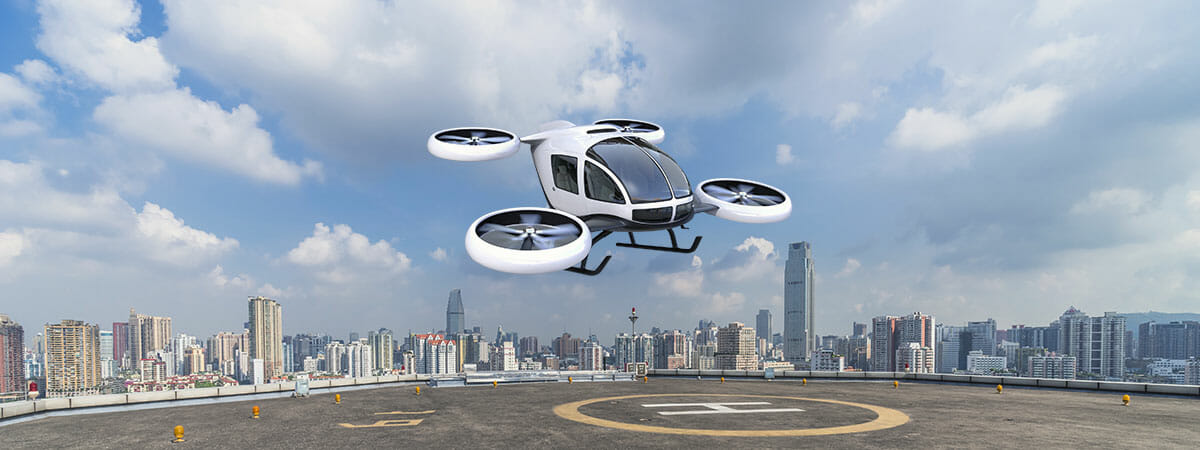We have been dreaming about them for many years and they are finally here. They are the “flying cars”. They may not look like a wheelless car, nor do they work with mysterious technologies that make them levitate without wings or rotors, as we saw in Blade Runner, Star Wars or The Fifth Element, but they undoubtedly represent a range of new solutions for the urban mobility of the future thanks to the developments of Airbus, Joby, E-Hang, Eve, Lilium or Volocopter and others.
AAM will shortly become a reality; therefore, it is precisely now when an effort must be made so that the infrastructures can guarantee the efficiency and safety required by the system.
It is possible that the day will come when everyone has a VTOL parked in front of their house, an acronym that defines an aircraft capable of taking off and landing vertically (Vertical Take-Off and Landing). We will probably be able to move with the same or greater level of freedom with which we use cars today, but the concept and ecosystem of advanced air mobility (AAM) that is currently being developed take us down another path, limited by technology and navigation rules.
It is already foreseen that creating node-based networks will be necessary that include infrastructures that serve as an exchange interface between users subject to land-based mobility and aircraft in their airspace. The most characteristic representation of these infrastructures will be the vertiports.
Focusing on the transportation of people, we must consider that AAM will have little to do with current commercial aviation. AAM will entail much shorter flights with small aircraft with a capacity limited to between 2 and 6 passengers, at low altitude, and frequently without leaving the urban environment.
We can surely find more similarities with helicopter air taxi flights that currently exist for executives in Sao Paulo (Voom, which ceased operations in 2020) or New York (Blade), especially in terms of technical requirements for aircraft operations; but AAM must serve a much higher volume of passengers and frequencies than what these heliports currently serve.
In addition, although the presence of a human pilots on board is initially foreseen, the most logical trend in the medium term, in terms of safety, efficiency and economy, is for flights to be remotely piloted or fully autonomous.
The keys to a successful conception of vertiports and other infrastructures for AAM is that they respond to the needs of the use cases that will initially begin to arrive onto the scene. Likewise, in the case of a transportation concept that begins from scratch, said concepts, whatever they might be, must be based on modularity and versatility that guarantee their growth and adaptation to future needs.
Needs of the sector
Although several studies (AERTEC, Roland Berger, KPMG, etc.) exist focusing on this new form of transportation that contemplate the development of various use cases, we must always consider the context of each local scenario, as greater guarantees of success will exist for the development of some specific solutions depending on the geographical, demographic, socioeconomic or environmental characteristics of said scenarios.
Let us think, for example, of the singularity of a territory divided by large bodies of water (e.g., an archipelago or a large river), without infrastructures that can link the connections (due to the existence of mountains or forests), or with permanently congested land infrastructures (as happens hypertrophic cities that have lacked urban planning in keeping with their population growth). All of these will be favorable scenarios for the development of AAM.
If we do not want the use of AAM to be marginal within the range of mobility options, we must seek solutions that ensure AAM can be seen as a step forward for society, focusing on the following aspects.
- Compliance with the highest safety standards: AAM must be perceived as safer than any of the existing land or sea means of transportation. This perception is emphasized in air environments, where a predominant feeling exists that the consequences of an accident can result in greater fatality.
- Uses with social benefits: Society can more easily embrace and accept AAM if it is used to cater to public services where the advantages of AAM are easily perceptible (medical emergencies, for example).
- Contribution of greater added value with respect to existing alternatives: AAM must have competitive advantages over land or sea means in terms of cost, comfort, time, sustainability, reliability and/or safety.
- Mitigate and counteract negative externalities: Issues such as noise, the protection of individual privacy or the protection of bird life are sensitive for society and AAM should not introduce new problems that are not offset with broader benefits for society.
- Affordable for broad sectors of the population: Acceptance by society to have new aircraft flying over their heads and homes; making urban land and significant electrical power available for vertiports is greatly facilitated as more people have access to AAM and consider it useful.
For this reason, some of the most interesting use cases that are identified in the incipient AAM ecosystem are:
- Express transportation service to airports (airport shuttle)
- Transportation of passengers to remote areas or areas that are difficult to access by other means (extended connectivity, which can be organized with an on-demand service, or with scheduled flights)
- Medical emergency services (air ambulance)
Any of these use cases requires infrastructures that, as we have already mentioned, facilitate the exchange between the air medium and ground services. In the next post (see here) we will address these infrastructures, focusing on key aspects such as technology, regulation and what is possibly the biggest challenge, winning broad acceptance by citizens.

#uam


